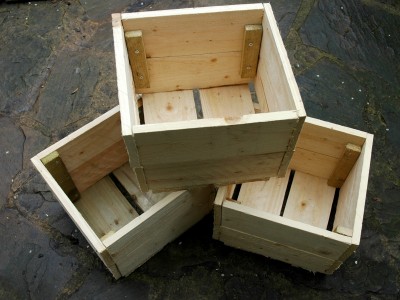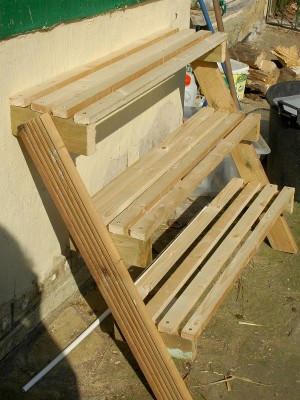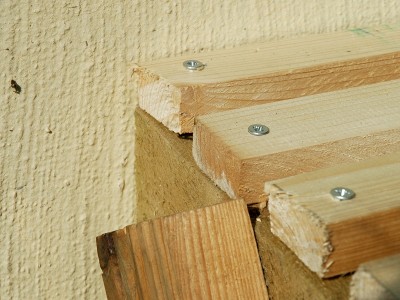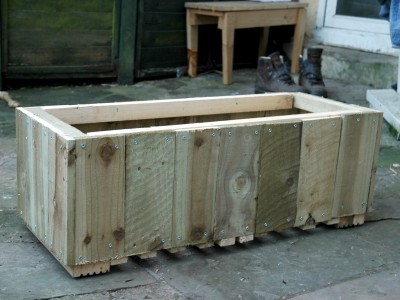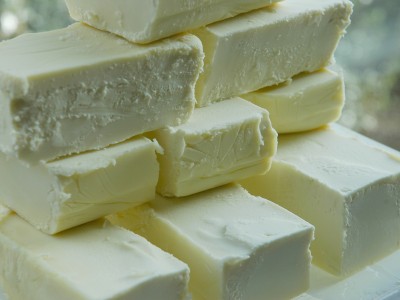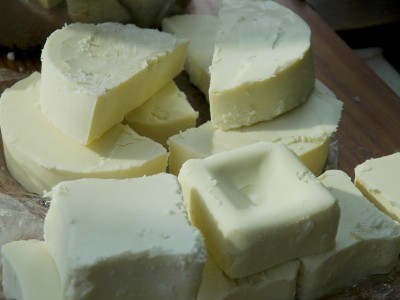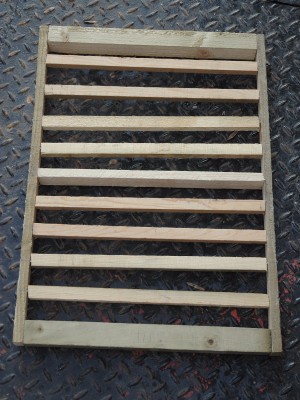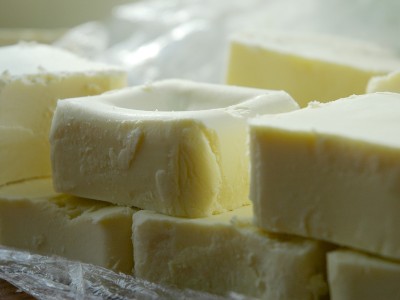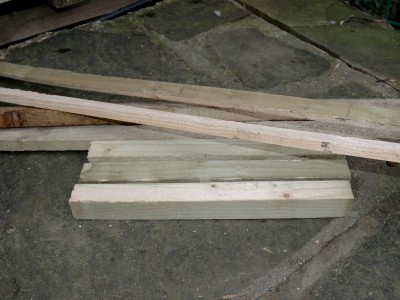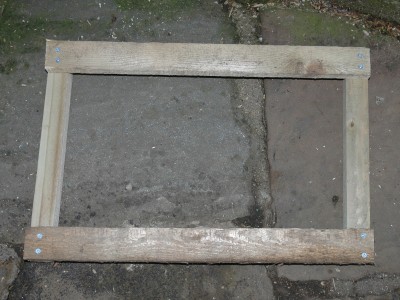More scrap wood planters
These are WIPs rather than finished articles but I wanted to mention them anyway because it’s pretty much all I achieved over the weekend – I had a nice quiet weekend, just not as productive as normal.
On Friday afternoon, I had that “I must make!!” craving so I went to hunt around in the (supposedly for burning) wood store for scraps to planters – I found 30 plank offcuts, roughly the same length (about 25cm/10ins) and width (13cm/5ins) and 12 batten offcuts, about 15mmx30mm. I’d intended to make another long trough but I realised those pieces would make three 25cm/10inch-cubed planters without having to saw anything at all – win!
(I don’t mind sawing now that we have a decent saw that treats everything like butter – but I like to avoid it whenever I can because I’m lazy and always end up with wonky cuts :) )
As with the other planters I’ve made, these aren’t exactly working examples of right angles or beautiful to look at but they’ll do. They’re finished in terms of building but the planks were all untreated and while I’ll line the inside anyway, I think I’m going to have to treat or paint the outside to make them more weather resistant. As we’re painting the bathroom soon, we should have some paint leftover from that which I can use.
The other planter I started yesterday afternoon before I had to rush off to a not-great dress rehearsal. I went down to the bottom of the garden to look for pallets (to make a vertical planter like the one Emma suggested) but the only ones down there are too big/heavy – but I did find some old, weathered fence boards/paling, which John’s dad had salvaged & brought over at some point, so I decided to make another long trough planter from them. I’ve made up the long sides – using a salvaged/scrap 2by4 cut into quarters for the corner supports/feet – but haven’t attached the short sides or base yet. It’s going to be 120cm/4ft by 60cm/2ft when it’s finished so I might end up removing the feet and resting the base on the floor so it doesn’t have to be strong enough to support all that weight. I’m going to enlist John’s help with fixing on the sides – I’m hoping that two of us working together can actually get the angles square for a change!
While I was doing that yesterday, John was at his mum and dad’s house for lunch and his dad excitedly told him about his latest find for us — apparently the sawmill/joinery place he gets a lot of offcuts from had some 5m (16ft) lengths of decking going begging this week – salvaged from a replacement job or something. According to John, his dad now has a crazy idea for us to make some 5m long planters – that might be a little nuts! Perhaps I should work on my sawing skills after all…
Read MoreAdventures in frugal vertical gardening – ideas for planters?
Got a dull flat wall I’d like to “vertical garden” up – need to make/acquire/modify some planters. Any suggestions? Need to be cheap/free :)
I asked that grammatically horrific question on Twitter last Thursday but I thought I’d bring it over here as well to catch non-Twitterers but also to put together some of my ideas/questions.
I’ve actually got two flat walls that would be perfect for wall planters and the like but I’m going to focus on the bigger one first. It’s on the greenhouse level of our garden and has a super narrow (about a foot wide) bed at the bottom of it. I intended to grow beans and peas in the bed last year – trained up the wall – but the slugs put an end to that. Courgettes grew quite happily in it after all the peas got eaten but I think from this year onwards, it’ll work better as shrubby-herb bed (especially as it means I don’t have to put those elsewhere now). Since they won’t climb up, there will be a lot of vertical height going spare. More of an issue for when I reach the planting stage but if anyone’s interest, the wall is east facing, receiving sun until about 1-2pm.
So what can I use for planters? There are lots of different planters available to buy – in all sorts of materials – but they seem to fall into a few general categories:
- shelves – from basic wood to fancy wrought iron curves & cages. Even the flatter, plainer shelves, usually have a rim or lip around the sides so pots don’t get blown out or down. For use with separate pots.
- window boxes – wall mounted troughs which, unlike the shelves, are planted into directly.
- half moon wall planters – semi-circular troughs a cross between window boxes and hanging baskets.
- hanging baskets – suspended away from the wall on a strong bracket or a hook. A few levels can be hung together like rainchains.
- “floating” pots – either like this lead one from Gardeners World, this integrated hooks/trellis arrangement or just pots on hooks. Some, like the lead one, have pots fixed in position, whereas others can be moved around – for example, pots with individual hooks attached can be put anywhere on a trellis.
- bags – suspended bags filled with soil, with holes cut into the (randomly) bag for the plants. Felt pocket hangers are a cross between the floating pots and these bags. Some bags (like better feather duvets) are divided into different compartments so the soil doesn’t all slump to the bottom – but this does restrict root growth.
- complex living wall systems – patented growing secrets! Lots of different designs/methods – some of them seem to be grid structures filled with compost, others structured bags behind trellis type things, others still who knows? possibly pure magic.
I certainly can’t afford a fancy living wall system but even filling the space with purpose-built troughs/window boxes, wall planters and hanging baskets would cost more than I’d like. (I do have some that I can repurpose from elsewhere in the garden but I’ll have to replace those containers somehow or I won’t be adding to my overall growing space. Some are also self-watering which would be beneficial). As always, I’ll keep an eye out on eBay/Freegle for giveaways but in the meantime, I guess I need to get making…
Read MoreTiered plant stand made from scrap wood
Yesterday I mentioned I finished off my latest scrap wood creation – a plant stand thing.
I can’t remember whether I went looking for inspiration or whether I stumbled upon the idea while looking for something else but about a month ago, I got very excited about the idea of making a tiered plant stand thing which would allow me to double, triple or maybe even quadruple the amount of plant pots I could have in any one area.
There are a few different sorts out there, with different supports and shelves, and I collected a range of pictures together to come up with my own design – one that would be versatile (long shelves not just trays for shelves – although that would use a lot less wood) but most critically, easy to make with my less than stellar woodworking skills. And this is what I came up with:
If it looks wonky, it’s because the floor there is uneven, I spent AGES getting everything level! It was a bit of a pain working out all the angles – I had to use MATHS! ;)
It’s pretty sturdy – supported against the wall by both the top shelf supports and the back batten of the top shelf. I made the side bits – from salvaged decking John’s dad brought over and some joiner’s off-cuts from our woodstore – a few weeks ago but couldn’t find any lengths for the shelves. Then I found six 18mmx38mmx1800mm battens in the garage yesterday, which worked perfectly. Since the wood is all a bit mismatched and it’s not all protected, I think I’m going to paint it with some leftover-from-decorating paint.
The shelves are about 90cm/3ft long, so I’ve now got 270m/9ft of linear growing space in less than a metre of ground space – and all of it raised off the ground which will hopefully deter slugs even the tinest bit!
As it was a bit of an experiment, I’m rather happy with it – another freebie for the garden – hurrah for scrap wood! This stand will probably live where it is now – underneath the office window – but I might make another one for the balcony next to the kitchen for easy-grab salad & herbs.
Read MoreAnother scrap wood planter
It was too nice today to sit inside – a cold, dull start but warmer this afternoon with some lovely soft winter sun lighting up the trees in the wood.
We had a lovely walk in the woods at lunchtime – we took out the neighbours’ year old springer spaniel as well as ten year old Lily, which was a fun change of pace. Sometimes Lily exhausts herself trying to keep up with him but today she was happy for him to run around like a crazy thing while she pottered along. We pottered too – he ran around more than enough for all of us.
After we’d got home from that, I did a quick hours work then headed into the garden to make another scrap wood planter. John’s dad brings us lots of short lengths of scrap timber – the end of planks from a joiners – which aren’t long enough to do much with, but I had an idea the other day for using them to make a planter – and this is the result:
Whenever I’m doing anything with wood, I try to minimise the amount of sawing I have to do because I’m lazy (and have an aversion to sawing after having an awful saw for a long time – the current one is actually really good and easy to use). Conveniently all the flat pieces for the sides and the battens for the bottom were already cut to size – or rather, the sides were all the same size and I let than dictate the height/width of the planter, then found enough suitably sized battens to fit along the bottom. It’s about 1m/3ft long and about 30cm/1ft wide & tall.
Like the other ones I’ve built, it’s made completely from scrap – the short lengths and reusing lengths of structural timber/decking that John’s dad has reclaimed/skip-dived – and I’ll line it with soil bags etc so the only cost are the screws. That was not inconsiderably on this one though – I used a lot of screws! – but at least it’ll double as a really small bomb shelter if we ever have another blitz. ;) If some flat wood – about 1cm by 5cm – turns up, I might use it to make a pretty lip to cover up (and protect) the top rim.
I’m really enjoying making these planters at the moment and hope to get another couple made before I need to start concentrating on planting things in them!
Read MoreMy first soap
I made some soap for the first time last week. It took FOREVER to trace. I wrote a blog post about that but didn’t explain any more about my soap making because, well, frankly, at that point, it looked like it was going to be a big fat fail.
Even though it had reached what could be considered trace, it still felt very sloppy when I was pouring it into the moulds and even overnight and over the next night, it was harder but still very soft. The directions I’d read had said to take it out of the moulds after a couple of days – mine would have still blobbed all over the place at that point. But it clearly was still curing and it was more than ready to leave the moulds today – a week after it was made. (It was probably ready for tipping out by Wednesday – it was a lot paler and seemed like it would hold its shape – but I was just busy with other stuff so thought it would be better to leave it rather than rush it.)
I made two batches – I’ll post the recipes & cost breakdown once I know that it is actually a success and they’re good to use but for now, I’ll say the first was a 100% olive oil soap, and the second was a third olive oil and two-thirds other generic veg oils/shortening — everything bought from supermarkets. As I’ll explain more when I review the two soap-making books I bought, we’re pretty utilitarian when it comes to our soaps – we want them to get us clean, to not be harsh & drying, and to smell alright. We want them to create minimal waste & be as frugal as possible. This is particularly important for me while I’m learning the skills – if I make a mistake, it’s nothing more than a few quid and some time; if I was buying neem oil, shea butter and essential oils, I’d not only be paying more for the ingredients, I’d be paying for postage & packing too and having to wait for them to arrive too.
As expected, the 100% olive oil soap is considerably paler & already harder than the mixed oils one – the veg shortening keeps it that bit softer. Because I ended up making a lot more than I’d intended in one day, I had to get a bit more creative about the moulds than I thought I would at the start. The 100% soap used an old plastic fruit tray & an old deep oven tray as moulds.
The mixed oil one got the choicest mould – a long flat tray with a lid (from when we bought a big pack of ostrich burgers from the farmers market) – but its overflow containers weren’t as suitable really – one of the square olive oil bottles and an ice cream bucket. They were more awkward to use but have resulted in interesting shaped soaps.
Once I’d popped everything out and cut it to size, I thought “I’ll put this in the airing cupboard to keep curing and drying for the next few weeks”. Then I had a “doh!” moment – the airing cupboard got pulled out by our bathroom refitters on Monday! I hadn’t acted quick enough to keep the racks I’d made which would have been perfect as drying racks (I did though save the cupboard doors – one of which I used as a chopping board for the soap, and the others will make a raised bed). So anyway, I needed something to use for drying racks so yet again, I raided the scrap wood store and twenty minutes later:
A drying rack! It’s a very rough & ready job, done without any measuring hence the slats being a bit wonky, but it’ll do fine for this purpose.
Now the soap is on the new rack drying in the attic room. I guess I shouldn’t declare it a resounding success just yet until it’s finished and we can try it, but after a few days of foreboding failure, it looks a lot more hopeful now!
Read MorePortable chicken run from scrap wood & wire
I was in a bit of a sulk this morning. My weekends – now that the weather is getting better – usually involve playing out in the garden, or at least cooking up treats in the kitchen but this weekend, I’m out all day, both days, at a youth theatre event with the group I help teach. The event should be fun but, you know, not playing in the garden or making sugar-packed goodies. So I was sulking about losing my play time – until I realised there was nothing stopping me playing out this afternoon instead. Even after five years of self-employment, I still feel naughty playing out during a workday – but as soon as I realised I could, I was up and running for the box of screws and our scrap wood supplies.
I find it funny that I get so excited about making things from wood these days because a couple of years ago, I wouldn’t have thought I was capable of doing it. I’m quite a practical girl – I worked as a labourer one summer during uni and I’m happy to get my hands/clothes/face dirty with paint or mud or what-have-you – but I always thought that making things from wood was a Big Serious Skill that wasn’t for my sort. I don’t know why. Perhaps it was because we didn’t really do any big woodwork stuff at school – we did stuff on “resistant materials” (which included bits of woodwork as well as electronics and stuff with plastic/metal) and I remember making little bits of jewellery out of wood and plastic – but it was little things, nothing practical.
I think I started to get converted after we moved into this house just over a year ago – I wanted some airing shelves inside the boiler cupboard so I went over to the DIY shop across the road, bought some 38mm by 19mm lengths, and made them. I think I did a pretty good job – I made them easily removable in case we needed better access to the boiler and they’ve not fallen down yet. Then I decided I wanted a wellie stand for outside and after getting some advice from a friend who is handy with a saw & screws and a scramble around our scrap wood store, we had a shiny new wellie station in a couple of hours. And that’s when the addiction started. I’m not great at it by any means but every time I make something, I learn something new and have tons o’fun :)
Anyway, this afternoon’s project was a portable chicken run so I could let the chickens out of their main run more. I was inspired by Kate from Living the Frugal Life‘s poultry schooner – it would let me use the chickens to weed and de-slug the veg beds but wouldn’t need me watching over them the whole time (or chasing them around the woods when they got the taste of freedom). I wanted to do a hoophouse thing like Kate’s but didn’t have any material to make the hoops – so I ended up making a boring wood frame instead. At least it was all the boring wood was scrap so free though :)
I made the ends first and was a little surprised by how sturdy they were ;)
The sturdiness was beneficial as the only long lengths I could find were lighter than desirable – but with the sturdy end frames and some supporting struts in the middle, it still felt strong enough. So far, so good.
Read More


